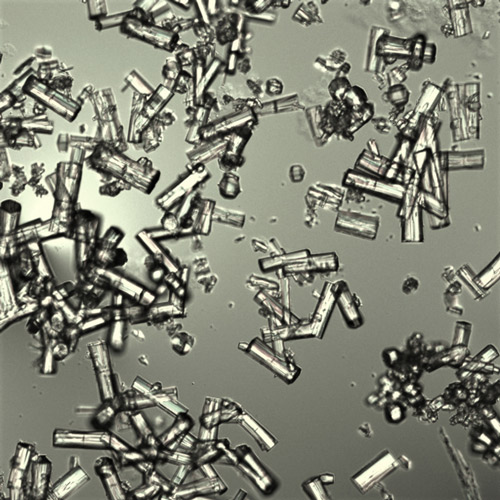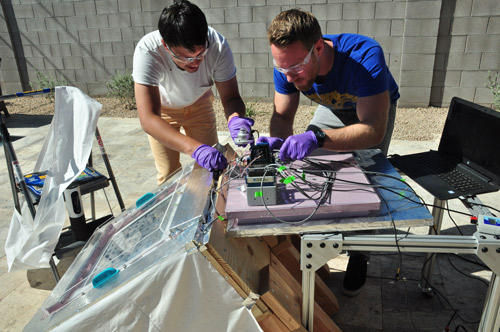Understanding longevity: From gene sequences to social inequity
03 April 2025
Published online 8 June 2018
Scientists harvest water from dry air in the Arizona desert using a device powered only by sunlight. But how practical is it?

© UC Berkeley
The key is in the development of a molecular powder, a metal–organic framework (MOF), that is highly porous and acts like a sponge to absorb water.
Packed in a frame at the top of a plexiglass box, the powder saturates with water during the moist, cool nights. During the day, it releases water as sunlight heats it. The water condenses against the sides of the box, which is insulated with dirt to keep the temperature low.
The box simply needs to be kept open at night and closed in the day.
“There is nothing like this,” says Omar Yaghi, lead author of the study published today, and the chemist who pioneered research into MOFs. “Here we have a solid, a molecular sponge, detecting water from a low humidity arid atmosphere and producing running water without any energy input aside from solar light. That’s an advance that was unimaginable before now.”
Yaghi, who is currently the James and Neeltje Tretter Chair at UC Berkeley and a faculty scientist at King Abdulaziz City for Science and Technology, Saudi Arabia, calls it a “next generation device”.
MOFs, which are made by mixing a metal salt with an organic part to create porous lattice-like structures, are already known for their water absorbing capacity. Last April, Yaghi, his research graduate Eugene Kapustin and a team from UC Berkeley and MIT published research on a small proof of concept device that under lab conditions created water droplets out of the air using 2 grams of a zirconium-based MOF2.
In the latest work, the UC Berkeley team used 1 kg of zirconium MOF spread an inch thick over a 16 × 16 inch frame. In a trial in the Arizona desert it produced 100 grams of water. Unlike the previous device, where thermoelectric energy was deployed to run a condenser, this ran without any additional energy input.
At $160 Zirconium is not cheap, so the team set about finding an alternative for testing in the laboratory under conditions replicating the desert experiment. The result was an aluminium-based framework MOF-303, which when combined with graphite, produced 175 grams of water – almost twice as much, at significantly lower cost. According to Yaghi, the price of aluminium is just $3.
It is also more environmentally friendly because the synthesis is run in water, rather than organic solvents.
The goal, Yaghi says, is to have the device last for years. The aluminium MOF was put through 150 continuous cycles, monitored for fluctuation and found to be stable.
The only factor the team seem not to have accounted for yet are dust storms. “If deployed widely it would have to have a filter, just like you would have a filter in your car,” Yaghi counters.
The blueprint for this new technology, he believes, is applicable the world over: “We [now] have mathematical relationships that allow you to build a box suitable for any desert climate — be it in the Middle East, Mediterranean, or Sahara. All you need are the solar plots, humidity levels and temperature difference. The same MOF can be used — only the configuration of the box will change.”
Yaghi is already working with King Abdul Aziz City for Science and Technology in Riyadh, Saudi Arabia, and its president, Prince Dr. Turki Saud Mohammad Al Saud, on the technology as part of their joint research Center of Excellence for Nanomaterials and Clean Energy.
All scientists that Nature Middle East spoke to agreed that the technology is interesting, that it shows the potential for tailoring MOFs to humidity conditions of less than 30 per cent, and that the scale and field trials represent a step forwards.
“The concept of harvesting water in arid regions is proven by this study. The ability to design and target MOFs based on relatively cheap starting materials brings affordable water in the desert via adsorption on MOFs one step closer,” says Mohammed Eddaoudi, chair of KAUST's chemical science programme. Peng Wang, associate professor at KAUST’s Water Desalination and Reuse Centre (WDRC), agrees, adding that “as an autonomous sunlight driven atmospheric water generator, it works well.”
“While it is not entirely clear whether this performance could result in significant impact in the ‘real world’ the article is clever,” says Tim Mays, Head of Chemical Engineering at Bath University, UK.

© Stephen McNally and Roxanne Makasdjian / UC Berkeley
Where Yaghi envisions applications ranging from a drinking fountain, to a household water tank or water harvesting farms, other experts are not so confident.
“Desert people will not be happy with just grams of water,” says Noreddine Ghaffour WDRC KAUST, whose research focuses on improving the performance of existing desalination technologies and energy-efficient processes. “The proof of concept works. We can catch water from low-humidity air. But the amount of water produced is too low for life.”
This concern was shared by Jan Hofmann, Professor of Water Science and Engineering at the University of Bath, UK and Director of the Water Innovation and Research Centre: “Human water consumption is about 150 litres per person per day, so the production capacity of the MOF is low. For 1,000 persons, 3,000 tons of MOF would be necessary to cover demand. This would mean MOF production at industrial scale, which is to my knowledge not existing yet.”
The water from the device, as it is distilled pure, is technically not fit for consumption. It would have to be remineralised to be worth drinking, he points out, a further process Yaghi and his team acknowledge.
Both scientists also shared concerns about the engineering issues involved in a scale-up — in particular energy efficiency, and heat and mass transfer. “These [issues] are a lesser issue at the relative small scale in the system as tested now, but will be a significant issue on the 3,000 ton scale or even at 100 kg,” says Hofmann.
There is no information in the current paper regarding costs of the latest device or the MOF. According to Kapustin there is no plan to run any kind of economic estimations. “Plexiglass, wood, water, and organic linker costs will be negligible in case of large-scale production. What’s more important is that our device does not require an additional source of energy or solar panels unlike other systems,” he says.
For Hofmann the new device is technology worth pursuing, although it will need significant development to create mature technology for an application.
For Ghaffour: “For the proof of concept — yes the science is there. Maybe it will be good for niche applications and specific off the grid situations. But practically, we cannot sell hope to desert people who are waiting for water to live.”
doi:10.1038/nmiddleeast.2018.66
Stay connected: